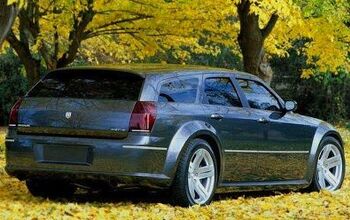Piston Slap: Design Talk On the Wide Track

BG writes:
Hi Sajeev! I am a big fan of TTAC and visit it almost every day. I have a question for you, so here it is:
We’ve heard so much about the goodness of wide wheel tracks, where the wheels are pushed to its corner. And the benefit of this seem natural and easy to comprehend for me, better handling, better looks, perhaps even better interior room if the wheel wells can be made less deep. It’s the other end of the spectrum, the narrow wheel tracks, that I can’t understand. What could possibly be the benefit of having a narrow wheel tracks? For some reason it used to be so popular, nearly all cars featured them. Even after the wide tracks was popularized by Pontiac in the 1960s, most cars still came with wheels that are placed well inside its openings. The only reason for them I can think of to justify that is if you want to use wheel skirts or low, “barely there” wheel openings, the Bathtub Nash being a good example. But most of these cars with narrow tracks have full wheel openings, at least in front. Why the narrow tracks then, I wonder?
Sajeev Answers:
My answer for this theoretical “Narrow versus Wide Track” debate takes the path not taken: offroading on difficult trails. The newer Jeep guys (and gals) normally have wider track axles, but they tend to fare less well in certain competitions compared to older Jeeps with narrow axles. After all, what’s so great about a wide track if you have to make a three point turn to stay on the trail? Or have to slow down and lose a ton of momentum in the process?
Check out some (non-Arabian Peninsula) wartime footage and you’ll see vehicles with narrow tracks. I’m not saying that wide track vehicles let the bad guys win, but think about it: they have inherent benefits on American highways, but what if you need to scoot around in smaller situations without stopping? I wouldn’t mind a narrow track in Boston, much less Rome or Bombay.
Narrow tracks are one reason why the current Ford Ranger is such a hoot to drive compared to its superior competition from Toyota, Nissan and especially the full sizers. It turns on a dime, changes direction with ease, and it’s pretty hard to get stuck anywhere. So if you want a runabout, you want a narrow track. If you want more, get more elsewhere. And if you’re a safety freak who can’t stand the thought of someone rolling over in a narrow track vehicle, make active roll control standard and easily defeatable for those who know how to drive.
Send your queries to mehta@ttac.com. Spare no details and ask for a speedy resolution if you’re in a hurry.

More by Sajeev Mehta
Latest Car Reviews
Read moreLatest Product Reviews
Read moreRecent Comments
- 28-Cars-Later Actually Honda seems to have a brilliant mid to long term strategy which I can sum up in one word: tariffs.-BEV sales wane in the US, however they will sell in Europe (and sales will probably increase in Canada depending on how their government proceeds). -The EU Politburo and Canada concluded a trade treaty in 2017, and as of 2024 99% of all tariffs have been eliminated.-Trump in 2018 threatened a 25% tariff on European imported cars in the US and such rhetoric would likely come again should there be an actual election. -By building in Canada, product can still be sold in the US tariff free though USMCA/NAFTA II but it should allow Honda tariff free access to European markets.-However if the product were built in Marysville it could end up subject to tit-for-tat tariff depending on which junta is running the US in 2025. -Profitability on BEV has already been a variable to put it mildly, but to take on a 25% tariff to all of your product effectively shuts you out of that market.
- Lou_BC Actuality a very reasonable question.
- Lou_BC Peak rocket esthetic in those taillights (last photo)
- Lou_BC A pickup for most people would be a safe used car bet. Hard use/ abuse is relatively easy to spot and most people do not come close to using their full capabilities.
- Lorenzo People don't want EVs, they want inexpensive vehicles. EVs are not that. To paraphrase the philosopher Yogi Berra: If people don't wanna buy 'em, how you gonna stop 'em?


































Comments
Join the conversation
Don't know about narrow track, but narrow tires are better in off-road mostly because of better contact/friction with road caused by more weight per area. Wide tires are more prone to aquaplane for example. Same on snowy roads. Recall seeing one video about some developed 4x4 offroader where common land rover with wide tires almost floated in liquid mud with near to no friction at all, while car with narrow tires easily reached bottom of puddle and easily rode ahead. Probably same with snow/ice. Someone ever noticed uber-narrow tires on WRC/autocross cars for winter stages?
The sides of the car would probably stay cleaner with the wheels tucked further in.